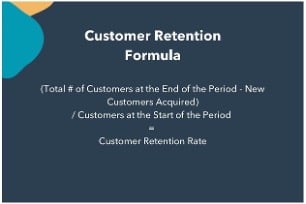Why Renewals Matter
Retention matters. It’s at the heart of your revenue engine and a major opportunity to stem losses. Even if you’ve addressed all your other sales problems, like staffing, processes, and tech, it will slow your growth because just to maintain an even growth rate, assuming each customer has a similar value, you must acquire one new customer for each one you lose. Alternatively, if you gain a new one and retain an existing customer, it’s like acquiring two.
Here’s what you’re facing:
23–30%
% of customers the average American company will lose each year due to a lack of customer loyalty
Source: Semrush
37%
rise in customer retention loss since 2016 due to poor customer service
$75B
the cost of customers feeling like nobody is listening to them
Another study found that 68% of consumers are willing to pay more if a vendor offers better customer service experiences, and 86% of customers say that good service will convert them from one-time buyers into long-term brand ambassadors.
A strong customer retention strategy is a gift that keeps giving. Follow these steps to optimize your existing customer relationships, enjoy greater ROI from keeping your customers, and inspire loyalty that keeps your customer acquisition costs low and your pipeline full.
STEP 1: Assess Your Retention Situation
Some customer loss is unavoidable. For a clear, inclusive view of your retention situation, you need to benchmark your churn, retention, and renewal rates. Then, work to set realistic goals.
Retention refers to when you keep a customer even though they’re eligible to end their contract with you. Here’s how to calculate your retention rate:

Source: Hubspot
Renewals are those customers who actively, intentionally renew their contract with you. Use this formula to calculate your renewal rate:

Source: Corporate Finance Institute
A lot of factors impact churn, such as industry, company size, and pricing model, but a good benchmark to shoot for is below the average, which, for B2B companies, is 5%. You can look at monthly or annual rates. If you’re subscription-based, monthly makes the most sense. Tracking monthly allows you to react more quickly to changing conditions; annual tracking gives you a summit view of issues likely impacting a broader swath of customers. Here’s a formula you can use:

Source: Salesforce
STEP 2: Monitor Renewals Closely
Create a customer experience dashboard to benchmark and monitor your renewals. You can do this in a CRM or similar tool. Include their history, level of use of and satisfaction with your product, how and how often they engage with customer support, how often and what problems they’ve reported, how quickly and well your team resolved those issues, how likely they are to leave, and why.
Create service-level agreements (SLAs) around core functions impacting customer experience, such as response times, issues resolution times and satisfaction, support best practices, and Customer Health Scores. Make it highly visible to all team members to keep it top of mind. Call out improvements in a bold way to draw attention to successes and to encourage continued efforts to drive renewals up.
STEP 3: Operation: Renewals!
Build a cocoon of support around your customers, and you not only capture those at-risk before they reach the point of no return but improve their experience so they’re less likely to want to leave.
Every team has the chance to impact the bottom line and a role to play in customer success, so aligning them around customer retention is critical. This may require addressing some systemic issues that take longer to fix, such as silos, realigning and training staff, securing cross-departmental buy-in, and setting long-term goals. But there are some strategies you can employ now.
Start by pinpointing and assessing your personnel, process, and infrastructure gaps that detract from renewals, such as broken feedback loops, customer response service-level agreements, or training for customer-facing staff. Prioritize short-term goals that are most achievable and will have the greatest impact.
Make sure each team knows their responsibilities and their opportunity to impact retention. Assign each team renewal-related metrics. Incentivize them for hitting incremental targets.
STEP 4: Understand your customers
This might be the most crucial thing you can do to drive renewals. Seek and demonstrate to your customers that you understand them. Approach every interaction with the objective of listening intently, asking the right questions, capturing those learnings, and using them to further the relationship by offering solutions to challenges, referring to how a particular product feature or function is addressing a need the client stated when they first bought your solution or product.
For Customer Success managers with a manageable number of customers, institute a deliberate touchpoint, to gauge and summarize the client relationship, what services and features they’re using/not using, and to assess what actions are important (to the customer) in the next X months. For those that are doing it at scale, setting up automated surveys or check-in emails offering online appointment scheduling ensures feedback loops and personal, yet sustainable outreach happens.
Conduct formal customer interviews or surveys (live and online). Consider engaging a third party, which allows the customer to be more open and honest, which they’re less likely to do with customer-facing staff. Create feedback loops to ensure their input goes back into the organization. Use automation to operationalize and streamline this process. Encourage your customer-facing staff to include their subjective views and instincts about the state of the relationship in your CRM. This ensures a human perspective remains in the relationship and captures the nuances of the relationship data can’t provide. Aggregate the feedback and share it across the organization (see strategy #2). A simple spreadsheet works, or you can store and track it in a CRM or Customer Success platform.
Use your onboarding process as an opportunity to glean and align closely with your customer’s exact goals and expectations. If you intentionally uncover those up front (both throughout the sales process and at the start of the relationship) and then refer to them overtly at key points in your interactions, you show your customer that you listened to them and that the things you’re doing tie back to THEIR objectives (such as deploying functionality, bringing a subject matter expert to the table to address a topic or concern, or even just following the roadmap of deployment, training, and ongoing learning).
It’s equally important to have an offboarding process. It’s your final opportunity to make customers feel valued and heard, which could impact their feelings about your company. You can also use their departure as an opportunity to learn from their decision to end their relationship with you and improve. Build exit interviews into your offboarding process, asking questions like:
- How did you arrive at your decision to end our relationship? Did something trigger it, or was it a pattern of experiences that led you to this point?
- Did you have trouble implementing or using our product, or did you face other issues?
- What were your expectations for your relationship with us, our products and services? How did we meet or miss them?
- Were there any areas/ways in which we failed to meet your expectations? Our company?
- Were there any areas/ways in which you were surprised by your interactions with our product, staff, support, or service?
- Did you receive enough and the right kind of product training? Did we enable you to put our product to its best use for you?
- Did our product solve the problems you hoped it would? Why or why not?
- What have been the most enjoyable moments of your interactions with our company?
- What have been the biggest challenges in working with our company?
- What could we have done differently to lead you to recommend us to others?
62% of customers say they share their bad experiences with others.
SOURCE: Salesforce’s State of the Connected Customer Report, Second Edition
Analyze and synthesize their feedback. Share it with your entire team to give them unvarnished insights into what matters to your customers and help them understand the opportunities for improvement. Prioritize what to address first and scope out actionable fixes. Assign action steps to the appropriate team members.
STEP 5: Build strong relationships on shared goals and mutual trust
Your team should feel like an extension of your customer’s team. You wouldn’t exist without them, but if you don’t demonstrate and communicate their value to your company, you miss an opportunity to build an enduring, mutually beneficial relationship. How do you live that out?
- Be transparent (about things like what you’re charging, your business practices, and your organization’s challenges as they pertain to your customer).
- Document their objectives right at the outset of your relationship. Routinely refer back to them as you tackle each new issue.
- Hold a 6-month and yearly review of their objectives. Find out whether they’re still accurate, need to be changed, or if they have new or additional objectives.
- Establish service-level agreements for responding to and resolving customer inquiries and complaints.
- Train your team to respond to all inquiries – including complaints – in a timely, complete, and thoughtful manner. Teach them to communicate in a way that conveys that their issues matter to you as if they were your own.
- Monitor and pass along information and insights on what’s happening in and shaping their industry.
- Offer to guide them in their budgeting and planning for the upcoming fiscal year and assist them with staffing projections (which skills they should be hiring for) and staff development (where levelling up skills could be beneficial and talent gaps exist).
- Ask them if you can support them by sharing performance metrics in a format that they could use in their annual planning document or in executive presentations.
Demonstrate that you understand and are intimately tied to their goals and their success, and they’ll come to trust you as an extended member of their team.
STEP 6: Deliver unforgettable customer value
Customer experience doesn’t just matter—it’s a key contributor to renewals. Data shows that customer dissatisfaction with the service they receive accounts for up to 68% of customer churn. And dissatisfied clients cost you future customers, as they’re certain to share their negative experience with roughly 10 others.
Customer expectations for your product matter. They shape their experience. Does your product live up to its promises? Can they realistically realize the outcomes they want from it? Is it priced to convey its value? Are you leaving product or service value on the table?
Customers are usually willing to pay more for a product with more features and better service. Evaluate your pricing strategy and make sure it’s in tune with and aligned to industry trends, the competitive landscape, customer demands, and the economic climate.
STEP 7: Advocate for your customer
A core role of Customer Success is to advocate for your customer. The most constructive way to build actionable advocacy on behalf of your customers is to organize and flag categories of common customer requests, issues, challenges, and wins in a spreadsheet, your CRM, or a customer success platform. Next, prioritize and rank your organization’s resources and activities available to address each of these by cost, strategic accounts, value, and results. By attaching quantitative data to subjective customer feedback, you can compartmentalize qualitative and emotional bias that might hinder progress.
Communicate the importance of recognizing and incorporating customer feedback to executive leadership, with an eye toward eventually securing buy-in and sponsorship. You’ll need internal cross-functional feedback channels to process positive and negative feedback, which will require periodic meetings between departmental stakeholders. A shared technology platform or tool can help keep internal stakeholders on the same page.
STEP 8: Craft strategies to address the central underlying reasons customers are leaving
Your renewal reality is being shaped before you gain a single customer. It may seem counterintuitive, but customers may be leaving because you were never suited for each other. Perhaps your product has changed but your target customer never did.
Examine your customer acquisition strategies for opportunities to minimize attracting customers who might not be a good fit. Are you screening them by the right criteria at the top of the funnel? Are you asking them the right questions? Marketing your product use cases rather than features is one way to give them a realistic view of your product and decide whether it’s right for them.
Re-examine your ideal customer profile. Does it align with the feedback you’ve collected from departed customers? Make recommendations to leadership about needed updates and places to close the gap.
Look at the feedback your exit interviews surfaced. Track and tally the issues so you can see how frequent each issue is and determine whether simple procedural fixes will address them or if you have a more systemic problem that’s hurting many relationships.
STEP 9: Track customer engagement
If you’re not already, track your customers’ engagement with you. Look at how and how often they reach out through direct channels like your customer support functions—live chat, help desk emails or calls, and support tickets. Look at the number of times/how often they’ve logged in to your customer portal and/or training platforms.
Don’t overlook less obvious channels such as commentary on social media platforms and customer reviews. Chances are you’ll come across unfiltered feedback you might not otherwise gain.
From there, build the scores into your customer experience dashboard and make it visible across your organization.
STEP 10: Make it hard to leave
Some churn is inevitable, but a significant portion is preventable. A lot of blogs tell you that the end of your relationship with your customer gives you one last, invaluable shot at retaining them. To bring out your A-team at that point so they just can’t walk away. But why not pour your resources and energies instead into giving them such a stellar experience from the get-go so they don’t want to leave—can’t pry themselves away? Rally your organization around helping your clients win, and watch your renewals grow.
Well before customers get to the point of no (or unlikely) return, assign your A-team and bring your A-game. Become part of their team. Be so tuned in to them that you know when they’re unhappy or whether it’s time to offer them other products or services that might benefit them. Learn how they’re using your product, and which features matter to them most.
Learn where your product can solve their problems and guide them to use it in those ways. Take time to ask about their goals and dreams, their most stubborn pain points, and what keeps them up at night. Anticipate their needs and wants. Constantly seek their feedback, be as transparent as possible, and try to close every loop with every issue they raise. Become a trusted advisor who offers them support and insights they can’t easily get anywhere else. They’ll recognize and reward you for leading them to success.
Build tools and strategies to flag and recapture customers before they churn. Build escalation triggers into your customer experience dashboard so that the appropriate person(s)/team will receive notifications as soon as service-level agreements aren’t being met. Create workflows to support your escalation processes. You may want to assign issue categories (pricing, support, training, product features, etc.) and/or risk of departure levels (minute, moderate, significant, high, dire) and route and handle them accordingly.
If you’re trying to save a customer who’s frustrated with support but loves your product, for example, interview them about the specific issues they’ve run into, escalate each one, address them as quickly as possible, and update them on the disposition of the solution frequently until you’ve resolved their issue. Make sure you have an evaluation process in place and report back to them on how their input is being fed back into the organization, so they know their voice matters.
Prioritize saving those customers who, for whatever reason, you know you have the resources to seek to retain.
If you’ve set triggers, are actively monitoring your dashboard, and are routinely interviewing your customers, you’ll be in tune with your at-risk customers and can apply the right strategies before a crisis pushes them out.
Our blog, Your Ultimate Tool to Improve Renewals: The Four Pillars of Customer Success, offers additional insights into how to build or shore up your Customer Success program and help your customers win. After all, isn’t that why you’re here?
Ready to talk?
Don’t want to go it alone? We can help you put Customer Success to work for you and inspire customer loyalty that keeps your acquisition costs low and your pipeline full.


